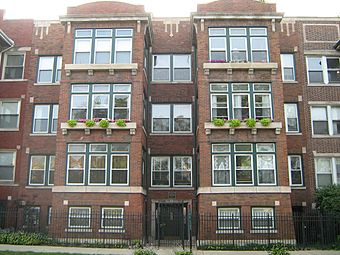Oscar Stanton De Priest House facts for kids
|
Oscar Stanton De Priest House
|
|
 |
|
| Location | 4536-4538 South Dr. Martin Luther King Jr. Blvd., Chicago, IL |
|---|---|
| Area | less than one acre |
| Built | c. 1920 |
| NRHP reference No. | 75000646 |
Quick facts for kids Significant dates |
|
| Added to NRHP | May 15, 1975 |
| Designated NHL | May 15, 1975 |
The Oscar Stanton De Priest House is a special apartment building in Chicago, Illinois. It is located at 4536-4538 South Dr. Martin Luther King, Jr., Drive. This building was built around 1920.
From 1929 to 1951, one of its apartments was home to Oscar Stanton De Priest. He was a very important person in American history. De Priest was the first African American to be elected to the United States Congress from a northern state. This building was made a National Historic Landmark on May 15, 1975. This means it is a place recognized for its importance to the history of the United States. The building is a private residence and is not open for public visits.
Contents
About the De Priest House
The Oscar Stanton De Priest House is on the South Side of Chicago. It is in an area called Grand Boulevard. You can find it on the west side of King Drive, just south of 45th Street.
This building is a three-story structure made of brick. It has stone details and a full basement. There are eight apartments inside, with two on each floor. The building has parts that stick out, called bays, on each side of the main entrance. You can also see flower boxes on the second and third floors. A decorative border, called a cornice, runs below the roof. The building's style shows it was built around 1920.
Oscar Stanton De Priest's Life
Oscar Stanton De Priest lived in one of the second-floor apartments. He lived there with his wife, Jessie De Priest, from 1929 until he passed away in 1951. De Priest was born in Alabama. In the late 1800s, he moved to Chicago. There, he worked as a building contractor, which means he managed building projects.
Early Political Career
De Priest became very active in local politics in Chicago. In 1904, he was elected as a Cook County commissioner. This was an important role in the local government. Then, in 1915, he made history again. He was the first African American to win a seat on Chicago's Board of Aldermen. He represented the city's wealthy Second Ward.
Serving in Congress
In 1928, Oscar De Priest was chosen to run for Congress. He joined the Republican Party ticket for Illinois's first Congressional district. The person who was supposed to run, Martin B. Madden, had passed away. De Priest won the election. When he arrived in Congress, some representatives from Southern states did not want him there. However, he was officially seated.
De Priest was the first African American in Congress since the Reconstruction era. He was also the first from any northern state. Because of this, he became a strong voice for African Americans. He worked hard to make sure that Black students received fair funding for their education. Oscar De Priest served three terms in Congress. After that, he returned to local politics in Chicago.


